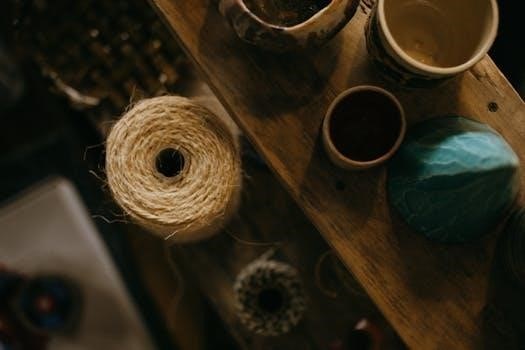
simple jelly roll rug pattern pdf free
Jelly roll rugs are a charming and colorful way to add a handmade touch to any home․ They are crafted from fabric strips, often from pre-cut jelly rolls․ These rugs offer a versatile, fun, and creative project for sewers․
What is a Jelly Roll Rug?
A jelly roll rug is a unique type of rug made by sewing together strips of fabric, typically from a “jelly roll,” which is a bundle of pre-cut 2 1/2-inch wide fabric strips․ These fabric strips are sewn around a core of batting strips, creating a spiral or coil that forms the rug’s base․ The result is a soft, textured rug with a quilted look, perfect for adding a touch of homemade charm to any room․ Jelly roll rugs are a fun way to use up fabric scraps or highlight a favorite collection of prints․ They can be made in various shapes and sizes․
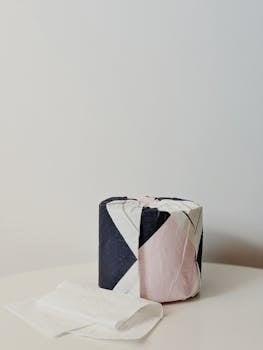
Materials Needed for a Jelly Roll Rug
To create a jelly roll rug, you’ll need fabric strips, batting, thread, and a needle․ These are the basic supplies to get started on your rug-making journey․
Jelly Roll Fabric Strips
Jelly roll fabric strips are essential for creating these rugs․ Typically, a jelly roll contains 40-42 fabric strips, each measuring 2․5 inches wide by the width of fabric (WOF)․ These pre-cut strips are ideal, offering a coordinated color palette․ Many find the variety of prints in a jelly roll bundle very appealing․ Using these strips allows for a visually appealing pattern and consistent width throughout the rug project․ They are readily available and convenient for starting your project․ You can also cut your own strips if desired, but pre-cut ones save time and hassle․
Batting for Jelly Roll Rugs
Batting is a crucial component in jelly roll rug construction․ It provides the rug’s structure and adds cushioning․ You can use pre-cut batting strips, typically 2․5 inches wide, or cut your own from batting yardage․ Two rolls of pre-cut batting, each 25 yards, are usually needed for one rug․ Some prefer 100% organic cotton batting for its softness and durability․ The batting is what will give the rug its body and help it to lay flat․ Ensure you use the correct amount for the size rug you want to make․
Thread and Needle Recommendations
Selecting the right thread and needle is essential for a sturdy jelly roll rug․ A strong thread like Maxilock serger thread is recommended for its durability and wide color range․ This thread will hold up well to the rug’s wear and tear․ A heavy-duty needle, such as a denim needle (size 14-16), is ideal to handle the bulk of fabric and batting․ Having extra needles on hand is helpful in case of breakage․ Using the correct needle will prevent damage to your sewing machine․
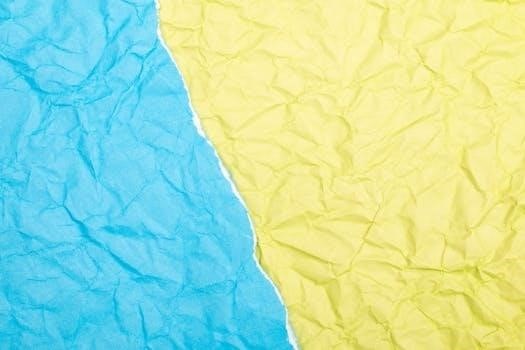
Basic Jelly Roll Rug Construction
Creating a jelly roll rug involves sewing fabric strips together, adding batting, and then shaping the rug as you go․ This process requires patience and attention to detail, but the results are beautiful․
Sewing the Strips Together
The initial step in crafting a jelly roll rug involves connecting the fabric strips from your jelly roll․ Begin by carefully aligning the edges of two strips and sewing them together with a straight stitch․ Continue adding strips, end-to-end, creating one long continuous fabric length․ Accuracy in this step is crucial for a smooth rug․ This lengthy strip will form the basis of your rug; make sure to keep the seams consistent․ It is important to press the seams as you go along, this reduces bulk and improves the final look․ This continuous strip will be used to form the rug’s base․
Adding Batting
Once you have a long fabric strip, the next step is adding batting․ This adds bulk and structure to the rug․ You can use pre-cut batting strips or cut your own․ Center the batting strip along the fabric strip and begin wrapping the fabric around the batting․ As you sew, ensure the batting is completely enclosed within the fabric․ This method creates a cord-like structure that is then coiled to form the rug․ Adding the batting now provides the necessary thickness and makes the rug more durable and comfortable․
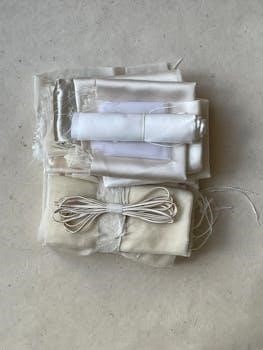
Different Shapes and Sizes
Jelly roll rugs aren’t limited to just one shape․ You can create oval, rectangular, or even circular rugs․ The size is easily adjustable by adding more or fewer fabric strips․
Oval Jelly Roll Rugs
Oval jelly roll rugs are a popular choice, offering a classic and versatile shape that fits well in many spaces․ To create an oval rug, you’ll begin by sewing your fabric strips together into one long continuous strip․ The construction process involves coiling and stitching the fabric strip, gradually shaping it into an oval․ The size can be customized by altering the length of the fabric strip used․ The finished product adds a soft, curved element to any room․ You can find free patterns online․
Rectangular Jelly Roll Rugs
Rectangular jelly roll rugs provide a structured and modern look․ These rugs are created by sewing fabric strips together and then shaping them into a rectangle․ This shape is particularly well-suited for hallways, entryways, and the sides of beds․ They can be made by sewing the strips together as if you are making an oval rug, but then shaping it into the rectangular form․ They offer a great alternative to the traditional oval shape and can be easily customized to fit specific areas․ Free patterns can be found online․
Finishing Touches
Once your jelly roll rug is constructed, proper finishing is key․ Ironing every 3-4 rows helps prevent waving․ Shaping ensures a neat and professional look for your rug․
Ironing and Shaping
Ironing is a crucial step in creating a flat and professional-looking jelly roll rug․ It’s recommended to iron your rug every 3-4 rows to prevent waving and ensure a smooth surface․ This process helps to set the stitches and flatten the fabric layers․ Shaping, on the other hand, involves carefully manipulating the rug into its desired form, whether oval or rectangular․ Gently coaxing the rug into its final shape contributes significantly to the overall aesthetic and functionality of your handmade creation․ Use steam for better result․
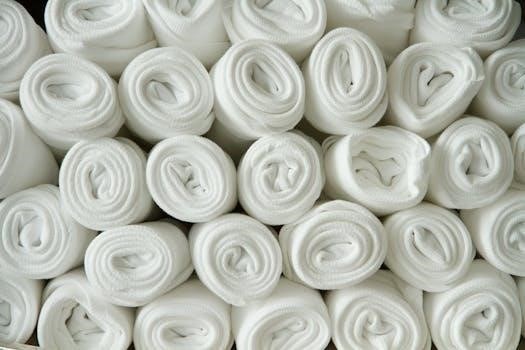
Free Jelly Roll Rug Patterns
Numerous free patterns are available online, offering various designs and sizes․ These resources provide step-by-step guides to help crafters create their own beautiful jelly roll rugs․
Where to Find Free Patterns
Finding free jelly roll rug patterns is easier than ever, with many resources available on the internet․ Websites like Pinterest host a variety of tutorials and visual guides․ Additionally, various quilting blogs and online crafting communities offer downloadable PDF patterns that include detailed instructions․ YouTube also offers video tutorials․ Many fabric shops provide complimentary patterns on their websites, often as a way to promote the use of their jelly roll products․ These sources offer options for all skill levels, ensuring everyone can find a pattern that suits their needs and preferences․
Tips and Tricks for Success
To ensure your jelly roll rug turns out great, iron frequently as you sew․ This will prevent waving and keep the rug flat․ Using a heavy-duty needle is recommended․
Preventing Waving
One of the most common issues when making a jelly roll rug is the edges waving or rippling․ To prevent this, consistent ironing is crucial; Ironing every few rows, about every 3-4, helps to keep the rug flat․ This process helps to set the stitches and manage the fabric bulk, ensuring a smoother, more even result․ Additionally, using the right size and type of batting can also contribute to preventing waves in your finished rug․ Be patient and take your time with the ironing stage for a professional-looking rug․
Choosing the Right Thread
Selecting the appropriate thread is essential for the durability and appearance of your jelly roll rug․ Given the heavy-duty nature of the project, a strong thread is recommended․ Many crafters prefer using serger thread, such as Maxilock, due to its strength and wide variety of colors․ A robust thread will withstand the use and washing of the rug, ensuring it holds up well over time․ Coordinating your thread color with your fabric can also enhance the overall look of your finished rug․ The right thread will make the project a success․
Care and Maintenance
Maintaining your jelly roll rug involves proper washing to keep it clean․ Regular care will ensure your handmade rug remains beautiful and lasts for years․ Proper care will preserve the rug․
Washing Your Jelly Roll Rug
Washing a jelly roll rug requires a gentle approach to maintain its shape and color․ Since these rugs are often made with cotton fabrics, it is important to use cool or lukewarm water․ Avoid hot water, which can cause shrinkage or fading․ You can hand wash your rug in a large tub with a mild detergent or use a delicate cycle on your washing machine․ If machine washing, place the rug in a mesh laundry bag for protection․ Always air dry the rug flat to prevent distortion․ Do not put it in the dryer․ Ironing after washing helps maintain its shape․